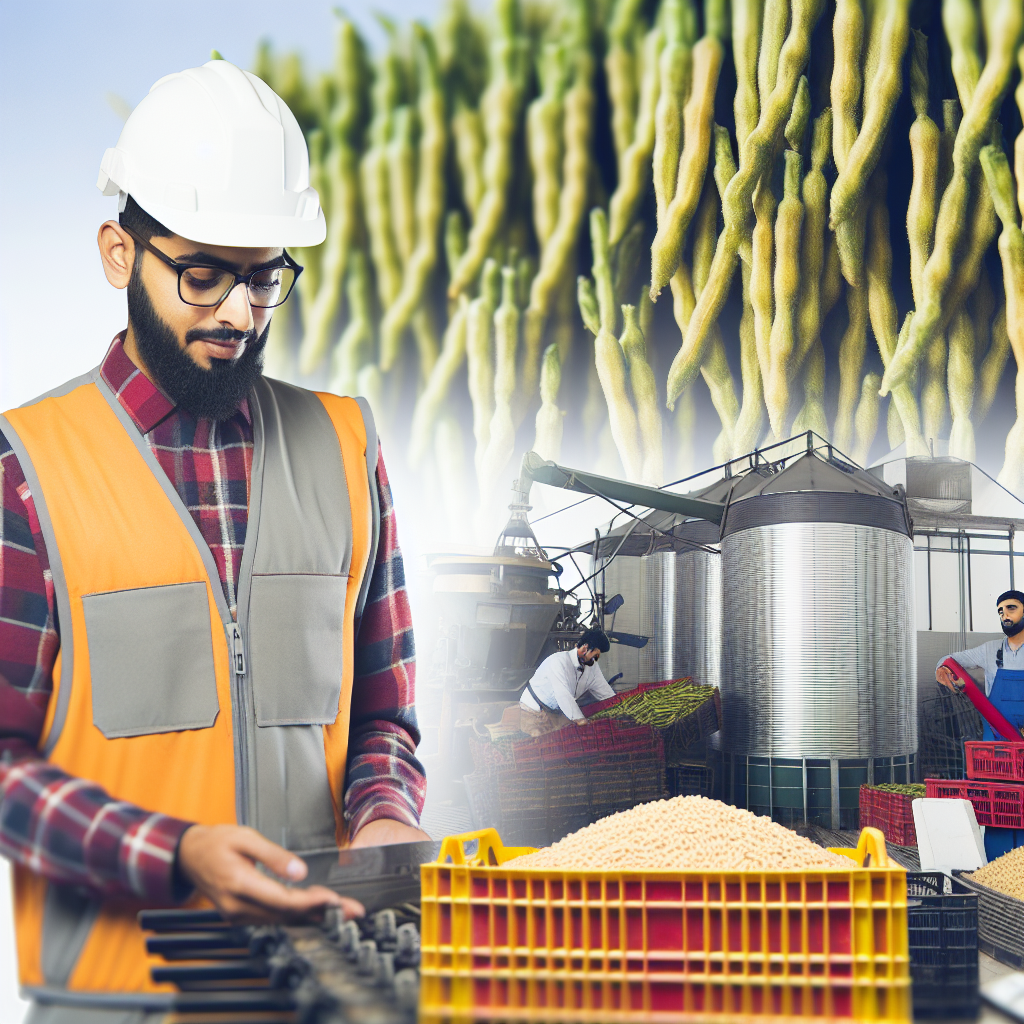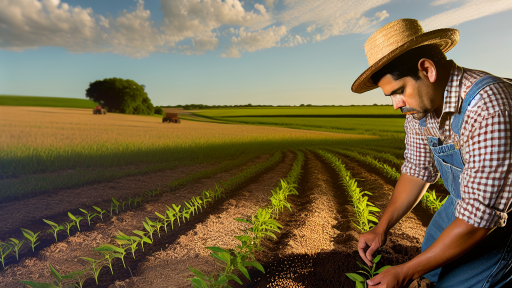Introduction to Sustainable Post-Harvest Practices
Sustainable post-harvest practices enhance food security and reduce waste.
They promote responsible management of resources in agricultural settings.
Effective post-harvest processes lead to higher quality products.
Additionally, they contribute to environmental conservation efforts.
Understanding these practices is crucial for farmers and consumers alike.
Benefits of Sustainable Practices
Sustainable practices reduce spoilage rates during storage and transport.
This reduction leads to improved food availability for communities.
Moreover, sustainable methods can lower production costs over time.
They can also enhance the marketability of agricultural products.
Overall, sustainable practices result in healthier ecosystems.
Key Techniques in Sustainable Post-Harvest Processing
Implementing cold chain logistics preserves product freshness.
Using biodegradable packaging minimizes environmental impact.
Regular training for workers ensures adherence to best practices.
Innovative drying techniques can retain nutrients while reducing waste.
Monitoring storage conditions helps maintain optimal quality.
Transform Your Agribusiness
Unlock your farm's potential with expert advice tailored to your needs. Get actionable steps that drive real results.
Get StartedImportance of Community Involvement
Engaging local communities supports the adoption of sustainable methods.
Knowledge sharing among farmers enhances overall practices.
Community-led initiatives drive innovation in post-harvest processing.
Furthermore, collaboration fosters a sense of shared responsibility.
Ultimately, community involvement strengthens regional food systems.
Importance of Sustainable Practices in Agriculture
Environmental Impact
Sustainable practices significantly reduce environmental degradation.
They promote soil health and water conservation.
Moreover, these practices lower greenhouse gas emissions.
As a result, they contribute to climate change mitigation.
Economic Benefits
Adopting sustainable practices can enhance profitability.
Farmers can lower input costs through efficient resource use.
Additionally, they access premium markets for organic products.
This approach fosters long-term financial stability.
Food Security
Sustainable agriculture plays a crucial role in food security.
It ensures a reliable and resilient food supply.
Furthermore, it helps communities adapt to changing climates.
This adaptability is vital for future generations.
Social Responsibility
Implementing sustainable farming fosters community well-being.
It supports fair labor practices and improves livelihoods.
Additionally, consumers increasingly favor ethically sourced products.
This shift drives demand for sustainable farming methods.
Methods for Reducing Food Waste during Post-Harvest Processing
Implementing Efficient Sorting Techniques
Efficient sorting techniques significantly reduce food waste.
Utilize technology to enhance sorting accuracy.
Invest in automated sorting systems to streamline processes.
Showcase Your Farming Business
Publish your professional farming services profile on our blog for a one-time fee of $200 and reach a dedicated audience of farmers and agribusiness owners.
Publish Your ProfileTraining workers on proper sorting methods improves efficiency.
Regular audits ensure compliance with sorting standards.
Optimizing Storage Conditions
Storage conditions directly impact food quality and waste levels.
Maintain optimal temperature and humidity for stored produce.
Utilize vacuum sealing to prolong freshness and reduce spoilage.
Implement a first-in, first-out system to minimize aging stock.
Conduct regular maintenance on storage facilities.
Promoting Creative Uses for By-Products
Use by-products creatively to minimize waste.
Transform leftovers into new products like jams or sauces.
Partner with local businesses to repurpose food scraps.
Encourage community workshops to educate on by-product utilization.
Document successful by-product innovations to share best practices.
Engaging in Community Outreach Programs
Community outreach boosts awareness of food waste issues.
Organize events that educate consumers on food preservation.
Collaborate with local farmers’ markets to reach wider audiences.
Develop partnerships with food banks to redistribute surplus food.
Measure community impact to refine outreach efforts.
Delve into the Subject: Using Technology to Enhance Post-Harvest Management
Energy Efficiency in Post-Harvest Technologies
Importance of Energy Efficiency
Energy efficiency significantly reduces operational costs in post-harvest processing.
It also minimizes environmental impacts associated with excessive energy consumption.
Efficient energy use can lead to improved competitiveness in the agricultural sector.
Innovative Technologies for Energy Saving
Adopting solar-powered drying systems can greatly reduce reliance on conventional energy sources.
Biomass energy systems provide a sustainable alternative for drying and processing needs.
Additionally, advanced refrigeration technologies help minimize energy use while preserving quality.
Implementing Best Practices
Regular maintenance of processing equipment ensures optimal energy efficiency.
Investing in energy-efficient machinery can yield significant long-term benefits.
Moreover, training staff on energy management can lead to better practices and reduced waste.
Measuring and Monitoring Energy Use
Tracking energy consumption helps identify areas for improvement in post-harvest processing.
Implementing energy audits ensures that facilities maintain optimal performance levels.
Utilizing smart technology offers real-time insights into energy usage patterns.
Collaboration and Knowledge Sharing
Engaging with industry peers promotes the exchange of effective energy management strategies.
Partnerships with local universities can foster research into new energy-efficient technologies.
Additionally, participating in workshops can enhance knowledge on sustainable practices.
Delve into the Subject: Preventing Soil Erosion in Organic Farming Systems
Water Management Strategies in Post-Harvest Processing
Importance of Water Management
Effective water management reduces waste during post-harvest processing.
It enhances the quality and safety of agricultural products.
Additionally, it supports sustainable agricultural practices.
Implementing Water Conservation Techniques
Farmers can adopt various water conservation techniques to minimize usage.
- Recycling water from cleaning processes boosts overall efficiency.
- Rainwater harvesting systems can supplement irrigation needs.
- Drip irrigation systems deliver water directly to the roots.
Utilizing Water-Efficient Technologies
Investing in water-efficient technologies proves beneficial for many post-harvest facilities.
Advanced filtration systems remove contaminants without excessive water usage.
Showcase Your Farming Business
Publish your professional farming services profile on our blog for a one-time fee of $200 and reach a dedicated audience of farmers and agribusiness owners.
Publish Your ProfileSmart irrigation controllers optimize water delivery based on real-time data.
Training and Awareness Programs
Training programs educate workers on effective water management practices.
Workshops can raise awareness of the importance of conserving water.
Moreover, creating an environment that encourages stewardship is crucial.
Monitoring and Evaluating Water Usage
Regular monitoring of water usage ensures compliance with set guidelines.
Data collection can identify areas to improve efficiency.
Furthermore, evaluating water management practices leads to more sustainable operations.
Discover More: Choosing the Best Mulch Materials for Your Farm
Utilizing Renewable Energy Sources in Processing Facilities
Benefits of Renewable Energy
Renewable energy significantly reduces operational costs.
It lowers greenhouse gas emissions effectively.
Additionally, it supports sustainable development goals.
Types of Renewable Energy Sources
Solar energy is highly popular for processing facilities.
Wind energy also offers a viable alternative.
Biomass energy can be harnessed from agricultural waste.
Implementing Solar Energy Systems
Solar panels can be installed on building rooftops.
They convert sunlight into electricity efficiently.
Facilities can use this electricity for their daily operations.
Challenges of Solar Energy Implementation
Initial investment costs can be high for solar systems.
Maintenance and efficiency are crucial factors as well.
Additionally, geographical limitations may affect performance.
Integrating Wind Energy Solutions
Wind turbines offer an excellent renewable energy source.
They can be placed on or near processing sites.
This harnesses local wind patterns effectively.
Overcoming Wind Energy Barriers
Site selection is critical to maximize wind efficiency.
Noise pollution can be a concern for nearby communities.
Regulatory permits may also pose challenges.
Utilizing Biomass Energy
Processing facilities can convert waste into energy.
This process reduces waste disposal costs significantly.
Moreover, it generates heat and electricity from waste materials.
Challenges with Biomass Implementation
Consistent feedstock supply can be a challenge.
Technology and equipment also require careful consideration.
Compliance with environmental regulations is essential.
Future Directions and Implications
Investing in renewable energy improves sustainability in processing.
It aligns with global efforts to combat climate change.
Transitioning to renewable sources is a necessary step forward.
Discover More: Mulching Strategies for Superior Weed Control

The Role of Technology and Innovation in Sustainable Practices
Improving Efficiency in Post-Harvest Processing
Technology revolutionizes post-harvest processing methods.
It enhances the efficiency of sorting, packaging, and storage.
Furthermore, automation cuts down labor costs significantly.
Technological advancements boost production rates and reduce waste.
Showcase Your Farming Business
Publish your professional farming services profile on our blog for a one-time fee of $200 and reach a dedicated audience of farmers and agribusiness owners.
Publish Your ProfileReducing Environmental Impact
Innovative solutions reduce the environmental footprint of agriculture.
For instance, solar-powered drying systems minimize energy consumption.
Eco-friendly packaging innovations decrease landfill waste.
Moreover, precision agriculture practices can lower chemical usage.
Enhancing Food Safety
Technology plays a critical role in ensuring food safety.
Advancements in monitoring systems help track food quality.
Smart sensors detect spoilage and pathogens in real time.
This technology builds consumer confidence in food products.
Supporting Smallholder Farmers
Innovation aids smallholder farmers to improve their practices.
Mobile apps offer guidance on best post-harvest strategies.
Access to market information helps them make informed decisions.
Consequently, they can increase their income and sustainability.
Promoting Research and Development
Investment in R&D fosters innovation in sustainable practices.
Universities and research institutions drive technological advancements.
Collaborations with private sectors lead to impactful discoveries.
Such partnerships accelerate the adoption of sustainable methods.
Case Studies: Successful Implementation of Sustainable Post-Harvest Practices
Introduction to Case Studies
Real-world examples provide valuable insights into sustainable practices.
These studies highlight effectiveness and adaptability in various contexts.
Reducing Food Waste in Ethiopia
A project in Ethiopia sought to minimize post-harvest losses.
It introduced improved storage techniques for grains.
Farmers received training on proper handling and storage.
This resulted in a significant decrease in food waste.
Participants reported 30% less loss after implementation.
Organic Pest Management in India
In India, farmers adopted organic pest management approaches.
They used botanical pesticides instead of chemical ones.
This practice improved crop quality and yield.
Farmers noted a reduction in harmful pesticide residues.
Consequently, the market value of their produce increased.
Solar Drying Techniques in Brazil
A cooperative in Brazil implemented solar drying methods for fruits.
This sustainable technique reduced their dependency on conventional energy.
Additionally, solar drying preserved nutritional quality effectively.
It improved market shelf-life for their products.
The cooperative’s sales doubled within two years.
Community Engagement in Kenya
A Kenyan initiative involved local communities in post-harvest practices.
Training workshops taught farmers about sustainable techniques.
This included proper drying and packaging methods.
The effort increased community collaboration and knowledge-sharing.
As a result, farmers reported higher income levels.
Technological Innovations in Post-Harvest Processing
Innovative technologies are reshaping post-harvest processing.
Mobile apps help farmers monitor storage conditions effectively.
Showcase Your Farming Business
Publish your professional farming services profile on our blog for a one-time fee of $200 and reach a dedicated audience of farmers and agribusiness owners.
Publish Your ProfileData-driven insights enable timely interventions against spoilage.
Moreover, these tools foster better decision-making among farmers.
Several regions reported enhanced productivity due to these innovations.
Future Trends in Sustainable Post-Harvest Processing
Adoption of Advanced Technologies
Advancements in technology lead the way in post-harvest processing.
For instance, artificial intelligence enhances sorting and grading efficiency.
Moreover, blockchain technology improves traceability of products.
These technologies also help reduce food waste by monitoring freshness.
Integration of Renewable Energy Sources
Utilizing renewable energy sources is gaining momentum in the industry.
Solar and wind energy can power processing facilities effectively.
As a result, businesses can significantly lower their carbon footprints.
Furthermore, this approach decreases operational costs over time.
Focus on Circular Economy Practices
Businesses increasingly embrace circular economy principles.
This model emphasizes minimizing waste and maximizing resource use.
For example, companies can repurpose by-products for other applications.
This practice not only reduces waste but also creates additional revenue streams.
Enhanced Quality Control Standards
Quality control standards are evolving to ensure sustainability.
With stricter regulations, businesses must adopt better practices.
Implementing rigorous testing ensures only the best products reach consumers.
Consequently, these efforts improve brand reputation and customer trust.
Collaboration with Local Farmers
Partnerships between processors and local farmers are growing.
These collaborations foster sustainable farming practices.
Additionally, they strengthen local economies and promote community engagement.
As a result, consumers enjoy fresher products with fewer environmental impacts.
Path Towards Sustainable Agriculture
Impact of Sustainable Practices
Sustainable practices significantly enhance post-harvest processing efficiency.
These methods reduce waste and conserve resources.
Moreover, they promote better quality products for consumers.
Adopting Innovative Technologies
Innovative technologies can streamline post-harvest operations.
For instance, automated sorting systems improve efficiency.
Similarly, precision drying equipment helps maintain crop quality.
Engaging the Community
Community involvement plays a vital role in sustainability efforts.
Local farmers benefit from shared knowledge and resources.
Moreover, educational workshops foster awareness of sustainable methods.
Choosing Eco-Friendly Materials
Eco-friendly packaging options reduce environmental impact.
Biodegradable materials are increasingly available for post-harvest use.
Additionally, using recycled materials conserves natural resources.
Monitoring and Evaluation
Continuous monitoring ensures practices remain effective over time.
Evaluating outcomes helps identify areas for improvement.
Consequently, adjustments can enhance overall sustainability efforts.
Building Resilience Against Climate Change
Sustainable practices increase resilience against climate fluctuations.
Implementing crop rotation strategies aids in soil health improvement.
Showcase Your Farming Business
Publish your professional farming services profile on our blog for a one-time fee of $200 and reach a dedicated audience of farmers and agribusiness owners.
Publish Your ProfileFurthermore, investing in water conservation techniques is essential.
The journey towards sustainable agriculture is ongoing.
Every effort contributes to a healthier planet and community.
As farmers and stakeholders unite, they create a brighter agricultural future.
Additional Resources
Sustainable Agriculture & Food Systems (SAFS) | University of New …




